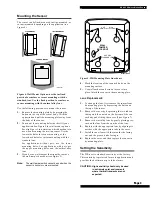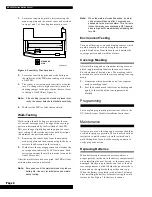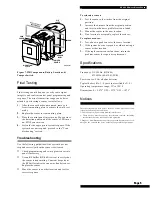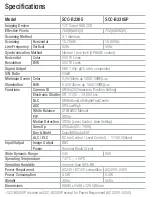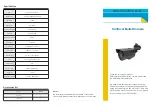
Page 4
NX-480 Wireless Motion Sensor
1.
Locate the sensitivity pins by first removing the
mounting plate and the sensor cover as described
in steps 1 and 2 of Lens Replacement process.
Figure 6. Sensitivity Pins Locations
2.
Locate the sensitivity pins under the battery on
the right side of the PIR when looking at the front
of the PIR.
3.
The sensor is set to standard sensitivity at the fac-
tory. To change this to high sensitivity move the
shorting jumper to the pair of pins that are closer
to the top of the PIR (see Figure 6)
Note:
If the shorting jumper is not used or placed incor-
rectly, the sensor defaults to standard sensitivity.
4.
Walk test the PIR to verify the sensitivity.
Walk-Testing
Walk- testing should be done to determine the sen-
sor’s actual coverage area. The edge of the coverage
pattern is determined by the first flash of the LED.
This may change slightly depending upon the sensi-
tivity setting. Walk test the unit from both directions
to determine the pattern boundaries.
1.
Removing the sensor body from the mounted
mounting plate and then remounting the body to
activate the 60-second walk test mode.
2.
Walk across the coverage pattern to determine the
coverage area, indicated by LED activation. Each
activation extends the walk test mode for an addi-
tional 60 seconds.
After the walk test mode has expired, the LED will not
activate when motion is detected.
Note:
Excessive use of the walk test mode may reduce
battery life. Use only for initial setup and mainte-
nance testing.
Note:
When the walk test mode has ended, an alarm
can be transmitted only after 3 minutes have
passed since the previous alarm. This 3 minute
lockout time reduces unnecessary RF transmis-
sions in high traffic areas thereby extending bat-
tery life.
Environment Testing
Turn on all heating or air conditioning sources which
would normally be active during the protection
period. Stand away from the sensor and outside the
coverage pattern and watch for alarms.
Coverage Masking
After walk-testing and environment testing are com-
pleted, apply masking labels to the sensor’s lens to
block detection of desired areas. The masking labels
provided are cut to match the corresponding lens seg-
ments.
1.
Determine which detection zone/lens segment
needs a masking label.
2.
Peel the desired mask label from its backing and
apply to the inside of the lens segment to be
blocked.
Programming
For complete programming instructions, refer to the
NX-Series Receiver Modules Installation Instructions.
Maintenance
At least once a year, the range and coverage should be
verified for proper operation. The end user should be
instructed to put the sensor in walk test mode and
walk through the far end of the coverage pattern to
verify proper detection.
Replacing Batteries
When battery replacement is necessary, observe
proper polarity (as shown in the battery compartment)
when installing the new battery, or the sensor may be
damaged. Be sure to note that as you look at the bat-
tery compartment, on the left side the positive side is
down and on the right side the positive end is up.
When the battery is replaced, wait at least 3 minutes
after installing the battery before activating the walk
test mode. See Figure 7 for battery locations.
8362G06A.DS4
STANDARD
HIGH



